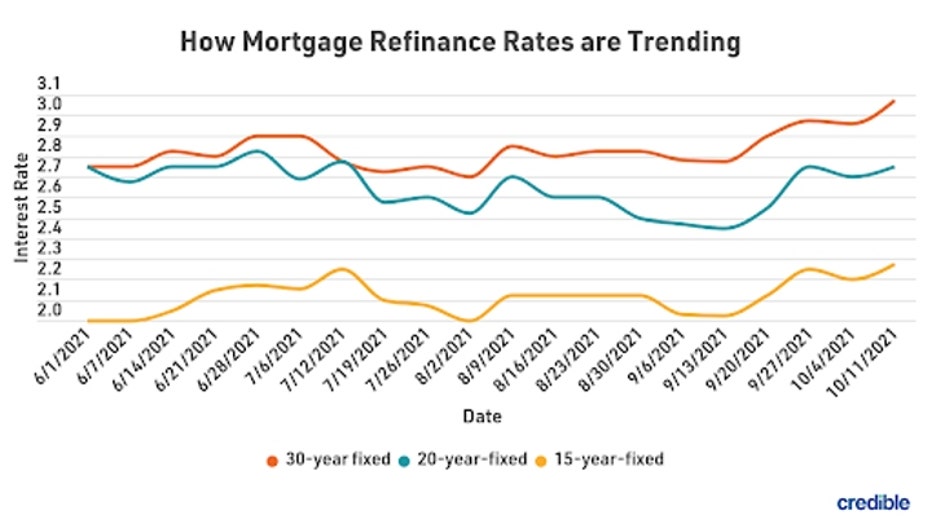Today's 30-year mortgage refinance rates creep back below 3% | Oct. 18, 2021
Our goal here at Credible Operations, Inc., NMLS Number 1681276, referred to as "Credible" below, is to give you the tools and confidence you need to improve your finances. Although we do promote products from our partner lenders, all opinions are our own.

Check out the mortgage refinancing rates for Oct. 18, 2021, which are mixed from last Friday. (iStock)
Based on data compiled by Credible, current mortgage refinance rates dropped for the longest term, remained unchanged for one term, and rose for two other terms since last Friday.
- 30-year fixed-rate refinance: 2.990%, down from 3.000%, -0.010
- 20-year fixed-rate refinance: 2.750%, unchanged
- 15-year fixed-rate refinance: 2.375%, up from 2.250%, +0.125
- 10-year fixed-rate refinance: 2.375%, up from 2.125%, +0.250
Rates last updated on Oct. 18, 2021. These rates are based on the assumptions shown here. Actual rates may vary.
Mortgage refinance rates for a 30-year term opened the week below 3%, meaning there’s still time for homeowners to score a deal by locking in a lower rate ahead of predicted rate increases. Meanwhile, 20-year rates have held steady at 2.750% for nine straight days. And rates for 15-year and 10-year terms, which are usually lower than longer terms, jumped up to 2.375%.
If you’re thinking of refinancing your home mortgage, consider using Credible. Whether you're interested in saving money on your monthly mortgage payments or considering a cash-out refinance, Credible's free online tool will let you compare rates from multiple mortgage lenders. You can see prequalified rates in as little as three minutes.
Current 30-year fixed refinance rates
The current rate for a 30-year fixed-rate refinance is 2.990%. This is down from last Friday. Refinancing a 30-year mortgage into a new 30-year mortgage could lower your interest rate, but may not have much effect on your total interest costs or monthly payment. Refinancing a shorter term mortgage into a 30-year refinance could result in a lower monthly payment but higher total interest costs.
Current 20-year fixed refinance rates
The current rate for a 20-year fixed-rate refinance is 2.750%. This is the same as last Friday. By refinancing a 30-year loan into a 20-year refinance, you could secure a lower interest rate and reduced total interest costs over the life of your mortgage. But you may get a higher monthly payment.
Current 15-year fixed refinance rates
The current rate for a 15-year fixed-rate refinance is 2.375%. This is up from last Friday. A 15-year refinance could be a good choice for homeowners looking to strike a balance between lowering interest costs and retaining a manageable monthly payment.
Current 10-year fixed refinance rates
The current rate for a 10-year fixed-rate refinance is 2.375%. This is up from last Friday. A 10-year refinance will help you pay off your mortgage sooner and maximize your interest savings. But you could also end up with a bigger monthly mortgage payment.
You can explore your mortgage refinance options in minutes by visiting Credible to compare rates and lenders. Check out Credible and get prequalified today.
Rates last updated on Oct. 18, 2021. These rates are based on the assumptions shown here. Actual rates may vary.

These rates are based on the assumptions shown here. Actual rates may vary.
Think it might be the right time to refinance? Be sure to shop around and compare rates with multiple mortgage lenders. You can do this easily with Credible and see your prequalified rates in only three minutes.
Rates last updated on Oct. 18, 2021. These rates are based on the assumptions shown here. Actual rates may vary.
The factors behind today’s refinance rates
Current refinance rates, like mortgage interest rates in general, are affected by many economic factors, like unemployment numbers and inflation. But your personal financial history will also determine the rates you’re offered when refinancing your mortgage.
Larger economic factors
- Strength of the economy
- Inflation rates
- Employment
- Consumer spending
- Housing construction and other market conditions
- Stock and bond markets
- 10-year Treasury yields
- Federal Reserve policies
Personal economic factors
- Credit score
- Credit history
- Home equity
- Loan amount, loan term, and loan type
- Debt-to-income ratio
- Location of the property
How to get your lowest mortgage refinance rate
If you’re interested in refinancing your mortgage, improving your credit score and paying down any other debt could secure you a lower rate. It’s also a good idea to compare rates from different lenders if you're hoping to refinance, so you can find the best rate for your situation.
Borrowers can save $1,500 on average over the life of their loan by shopping for just one additional rate quote, and an average of $3,000 by comparing five rate quotes, according to research from Freddie Mac.
Be sure to shop around and compare rates from multiple mortgage lenders if you decide to refinance your mortgage. You can do this easily with Credible’s free online tool and see your prequalified rates in only three minutes.
How does Credible calculate refinance rates?
Changing economic conditions, central bank policy decisions, investor sentiment and other factors influence the movement of mortgage refinance rates. Credible average mortgage refinance rates are calculated based on information provided by partner lenders who pay compensation to Credible.
The rates assume a borrower has a 740 credit score and is borrowing a conventional loan for a single-family home that will be their primary residence. The rates also assume no (or very low) discount points and a down payment of 20%.
Credible mortgage refinance rates will only give you an idea of current average rates. The rate you receive can vary based on a number of factors.
When is it worth it to refinance?
Refinancing a mortgage can be a great way to save money. But it’s not always the best move for every homeowner.
People refinance for a number of reasons, including to get a lower interest rate, change their monthly payment amount and lower their interest costs. Generally, if you can lower your interest rate by at least 0.75%, refinancing might be a good move.
Here’s an example of how refinancing can save you money: If you refinance your 30-year, $300,000 loan at 4% into a new 30-year loan with a 3.25% interest rate, you’ll lower your monthly payment from $1,432 to $1,306. That’s a monthly savings of $126, which adds up to $45,360 over the life of the mortgage.
But before you refinance, be sure to weigh closing costs, and calculate how long it will take before your savings from the refinance cover the expenses of refinancing.
Credible also has a partnership with a home insurance broker. You can compare free home insurance quotes through Credible's partner here. It's fast, easy and the whole process can be completed entirely online.
Have a finance-related question, but don't know who to ask? Email The Credible Money Expert at moneyexpert@credible.com and your question might be answered by Credible in our Money Expert column.
As a Credible authority on mortgages and personal finance, Chris Jennings has covered topics that include mortgage loans, mortgage refinancing, and more. He’s been an editor and editorial assistant in the online personal finance space for four years. His work has been featured by MSN, AOL, Yahoo Finance, and more.

